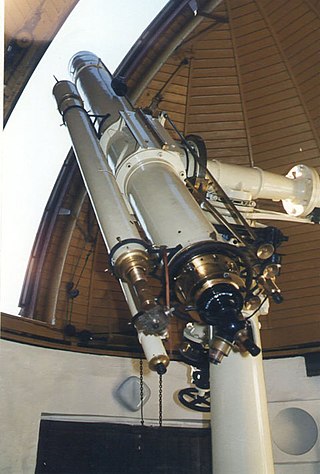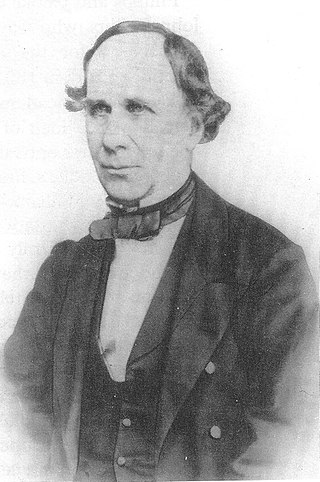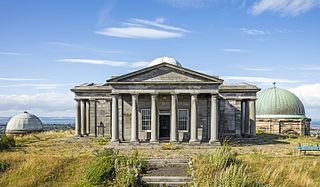
A refracting telescope is a type of optical telescope that uses a lens as its objective to form an image. The refracting telescope design was originally used in spyglasses and astronomical telescopes but is also used for long-focus camera lenses. Although large refracting telescopes were very popular in the second half of the 19th century, for most research purposes, the refracting telescope has been superseded by the reflecting telescope, which allows larger apertures. A refractor's magnification is calculated by dividing the focal length of the objective lens by that of the eyepiece.
Boyden Observatory is an astronomical research observatory and science education centre located in Maselspoort, 20 kilometres (12 mi) north-east of the city of Bloemfontein in Free State, South Africa. The observatory is managed by the Physics Department of the University of the Free State (UFS). The Friends of Boyden assist the observatory as a public support group, organising open evenings and protecting its public interest. Boyden also makes use of members of ASSA Bloemfontein Centre, the amateur astronomy club of the city, for presenters and telescope assistants.

Thomas Cooke was a British scientific instrument maker based in York. He founded T. Cooke & Sons, the scientific instrument company.

The Institute of Astronomy (IoA) is the largest of the three astronomy departments in the University of Cambridge, and one of the largest astronomy sites in the United Kingdom. Around 180 academics, postdocs, visitors and assistant staff work at the department.

The City Observatory was an astronomical observatory on Calton Hill in Edinburgh, Scotland. It is also known as the Calton Hill Observatory.

Space Place at Carter Observatory is an observatory in Wellington, New Zealand, located at the top of the Wellington Botanic Garden.

The Leander McCormick Observatory is one of the astronomical observatories operated by the Department of Astronomy of the University of Virginia, and is situated just outside Charlottesville, Virginia (US) in Albemarle County on the summit of Mount Jefferson. It is named for Leander J. McCormick (1819–1900), who provided the funds for the telescope and observatory.
The Amateur Astronomers Association of Pittsburgh (AAAP) is an Astronomical Organization founded on June 9, 1929, by Chester B. Roe and Leo J. Scanlon. Since its establishment, it has grown to have over 500 members and operates two observatories in the Pittsburgh region: the Nicholas E. Wagman Observatory and the Mingo Creek Park Observatory. The club also sponsors many star parties that are open to the public throughout the year.

The Royal Observatory of Belgium has been situated in the Uccle municipality of Brussels since 1890. It is part of the institutions of the Belgian Federal Science Policy Office (BELSPO).

Grubb Parsons was a historic manufacturer of telescopes, active in the 19th and 20th centuries. They built numerous large research telescopes, including several that were the largest in the world of their type.

The Norman Lockyer Observatory, the Lockyer Technology Centre, and the Planetarium, is a public access optical observatory 1 mile (1.6 km) east of Sidmouth, East Devon in South West England. It houses a number of historical optical telescopes, including the Lockyer Telescope, and is operated by Norman Lockyer Observatory Society (NLOS).

Mills Observatory is the first purpose-built public astronomical observatory in the UK, located in Dundee, Scotland. Built in 1935, the observatory is classically styled in sandstone and has a distinctive 7 m dome, which houses a Victorian refracting telescope, a small planetarium, and display areas. The dome is one of two made from papier-mâché to survive in the UK, the other being at the Godlee Observatory.

Coats Observatory is Scotland's oldest public observatory. It is currently closed for refurbishment as part of a 4-year long £42m transformation of the observatory and museum buildings. Located in Oakshaw Street West, Paisley, Renfrewshire, the observatory has been operational since 1 October 1883 and continues to function to this day, offering visitors the opportunity to view the night sky through the powerful telescopes housed within the building. The observatory is currently closed for redevelopment and is due to reopen in 2025.

Fuertes Observatory is an astronomical observatory located on the North Campus of Cornell University in Ithaca, New York. The observatory was designed by L.P. Burnham, Cornell Professor of Architecture and completed in fall of 1917. It was originally used by the Civil Engineering Department as an instructional field office for navigation and surveying. Today, the observatory is primarily used for public outreach, welcoming over two thousand visitors per year with open houses on clear Friday nights.

The Zagreb Astronomical Observatory is the astronomical observatory located in Zagreb, the Croatian capital, and founded in 1903. It is managed by the Zagreb Astronomical Society; its main purpose is educational.

McMillin Observatory was an astronomical observatory built around 1895 on the campus of Ohio State University. Named after Emerson McMillin and operated by the university, the observatory closed in 1968 and its telescope later moved to Ballreich Observatory. The observatory was equipped with photographic cameras, a filar micrometer, and a custom Brashear spectroscope. The observatory had two main focuses, education and at least one astronomic scientific research study focus.
Joseph Gurney Barclay FRAS was the son of Robert and Elizabeth Barclay. Joseph Gurney Barclay followed the banking profession for more than fifty years. In his later career he was head of the Barclay & Bevan bank and retired at the age of 80 when his bank amalgamated with others into a limited company in 1896, becoming Barclays. He was also a life member of the Meteorological Society.

The Observatory of the rue Serpente was an astronomical observatory owned and operated by the Société Astronomique de France in the historic Latin Quarter of Paris. It operated between 1890 until 1968, when it was transferred to a new location at the nearby Astronomy Tower of the Sorbonne.


















